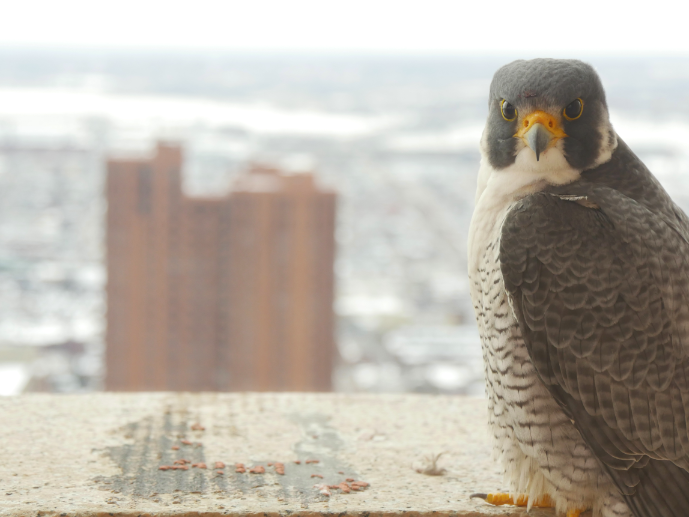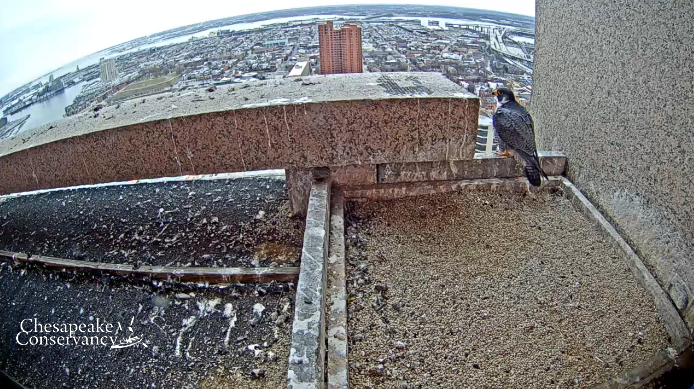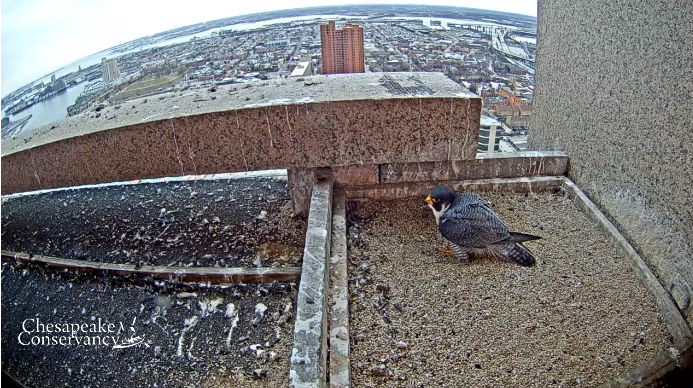
For more than 35 years, pairs of peregrine falcons have been living and hatching eggs high atop the 33rd-floor ledge of a Light Street skyscraper.
And now everyone, not just folks employed at the Transamerica building, can get a close-up look at the birds of prey, a region favorite, via a 24/7 video feed, courtesy of the latest Chesapeake Conservancy wildlife webcam.
The falcon webcam launched March 10, just in time for spring egg laying—which could happen any day now we are told. If all goes well, four-ounce, fluffy white baby falcons should be breaking their way into the world in the next couple of weeks. Helpless at first, peregines walk by about three weeks of age and begin flying by 12 weeks.
The new falcon webcam comes on the heels of the conservancy’s popular Kent Island osprey cam, which garnered more than 500,000 unique visitors last year from 123 countries. Those birds, nicknamed “Tom” and “Audrey,” can be viewed here. Ospreys, similar to peregrine falcons, faced a 90 percent population decline between 1950-1970 in the wake of DDT and other pesticide poisoning.
According to a chronology provided by the conservancy, a 1-year old falcon named Scarlett, released by ornithologists from the Edgewood Arsenal area on the Chesapeake Bay in 1977, turned up a year later on what was then the USF&G Building near the Inner Harbor. Now known as the Transamerica building, Scarlett successfully hatched four eyases in 1984—three females and a male. When she died later that year from a throat infection, her mate, Beauregard, was said to be heard mourning loudly from the ledge.
Although peregrine falcons generally mate for life, Beauregard would later mate with a banded falcon brought from New Jersey, producing numerous eyases into the early 90s. Ever since, pairs of peregrine falcons have been making their home—and baby falcons—with a skyline view of downtown Baltimore and the harbor.

With any luck, we’ll be able to watch the current pair, “Boh” and “Barb,” hatch a new crop of offspring. By the way, those little feathers you see rustling in the breeze near their nest? Those are leftovers from lunch. Peregrine falcons, for all their charisma, are tough guys, fierce birds that eat mostly, well, other birds.
After a steep post-World War II decline, peregrine populations have rebounded over the past two decades following large-scale breeding and release programs.
They get clocked at more than 200 miles per hour in flight, but if you look up at the right time on your next downtown visit, you might just catch a glimpse of Boh or Barb.

